In a sport cherished for its spirit of fair play and competition, the recent doping scandals in tennis have cast a long shadow. As Jannik Sinner approaches the end of a three-month suspension, scrutinizing the implications of his case reveals complexities that resonate beyond the individual athlete. With Sinner’s suspension, which stemmed from a positive test for clostebol due to contamination during physiotherapy, players within the tennis community are suddenly awakening to their vulnerabilities. The revelation that a seemingly innocuous massage could lead to such severe consequences sends shockwaves through the professional ranks, prompting many to question the protocols and protections surrounding anti-doping measures.
Seeking Clarity in Uncertain Times
The fallout from these incidents is palpable, with a marked increase in inquiries to anti-doping authorities. Players are now seeking guidance to navigate a labyrinth of rules and regulations that can often feel more like a minefield than a safety net. The International Tennis Integrity Agency (ITIA) has recognized this growing trend and is responding proactively by enhancing its support systems for athletes and their teams. The message is clear: there are resources available to ensure that players can avoid inadvertently moving into the territory of banned substances.
However, the unease remains; the tennis world is rife with apprehensions about unjust penalties. This fear is compounded by high-profile cases like that of Iga Swiatek, another budding star who faced a one-month suspension after testing positive for trimetazidine. Such instances reveal a broader issue within the sport, where the stakes continue to climb, and the margins for error shrink drastically. With so much on the line, players are reevaluating their relationships with coaches and medical staff, questioning whether they can trust that every treatment and supplement is safe.
The Duality of Justice and Perception
An essential discussion has emerged surrounding the perceived inequality in how doping cases are handled. Notably, figures like Novak Djokovic and Nick Kyrgios have publicly criticized the treatment of Sinner, arguing that he may have received leniency that would not be afforded to others. Djokovic lamented feeling “kept in the dark,” while Kyrgios branded the situation as “disgusting.” These voices bring to light a troubling narrative about fairness and transparency in tennis, urging the sport to confront its systemic issues head-on.
The disparity between public perception and judicial outcomes raises questions about the integrity of the anti-doping framework. Indeed, Serena Williams’s comments resonate as a stark reminder of how varying circumstances can lead to divergent penalties; a potential ban of 20 years for her had she found herself in Sinner’s predicament is a haunting possibility that lingers in the minds of many. The ITIA maintains that its processes are driven by facts, but trust may erode further without transparent dialogue.
The Road to Redemption
As Sinner prepares to return to competition, he is well aware that the path ahead is fraught with challenges. Despite triumphing at the US Open and defending his title at the Australian Open, the question remains: how will he recover from this crisis in reputation? While he optimistically notes that “the first games will be really difficult,” his resilience will be tested not only by physical performance but also by the mental toll a scandal imposes.
Rafael Nadal has offered measured support for Sinner, emphasizing the need to allow the young player to focus on his craft. As a seasoned rival, Nadal’s confidence in Sinner’s integrity reiterates the idea that mistakes can happen in high-stakes environments. His assurance that Sinner is “innocent and moral” attempts to help the younger athlete navigate the turbulent waters by establishing a positive narrative around the incident.
Rebuilding Faith in the Game
These recent doping controversies expose critical vulnerabilities within tennis, extending beyond the athletes directly implicated. They challenge the sport’s administrative bodies to fortify their protocols and restore faith in their systems. It becomes essential to ensure that all players, regardless of stature, are treated fairly while simultaneously emphasizing education on doping policies.
Ultimately, maintaining the sport’s integrity requires collective effort: players, coaches, medical professionals, and governing bodies must work together to ensure a transparent and fair playing environment. The conversations surrounding these issues resonate with urgency, as tennis grapples with safeguarding its values of fairness, competition, and respect. The time has come for the sport to rise above the fray, ensuring that the spirit of tennis remains untainted amidst the challenges ahead.


Leave a Reply